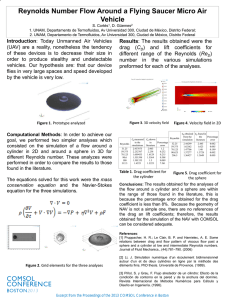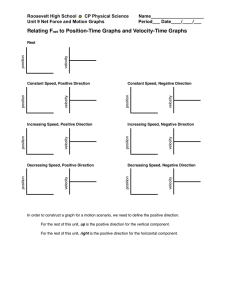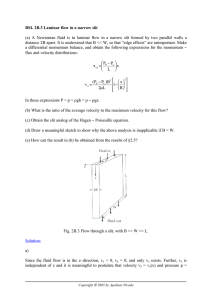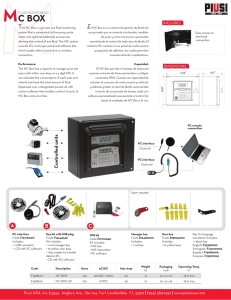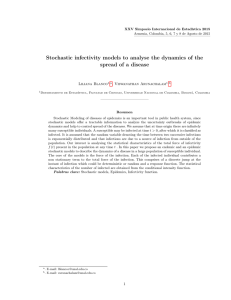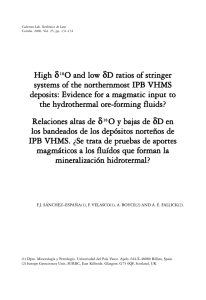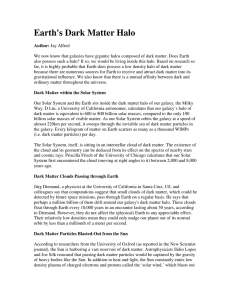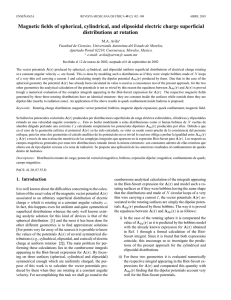Simulation of the motion of a sphere through a viscous fluid
Anuncio
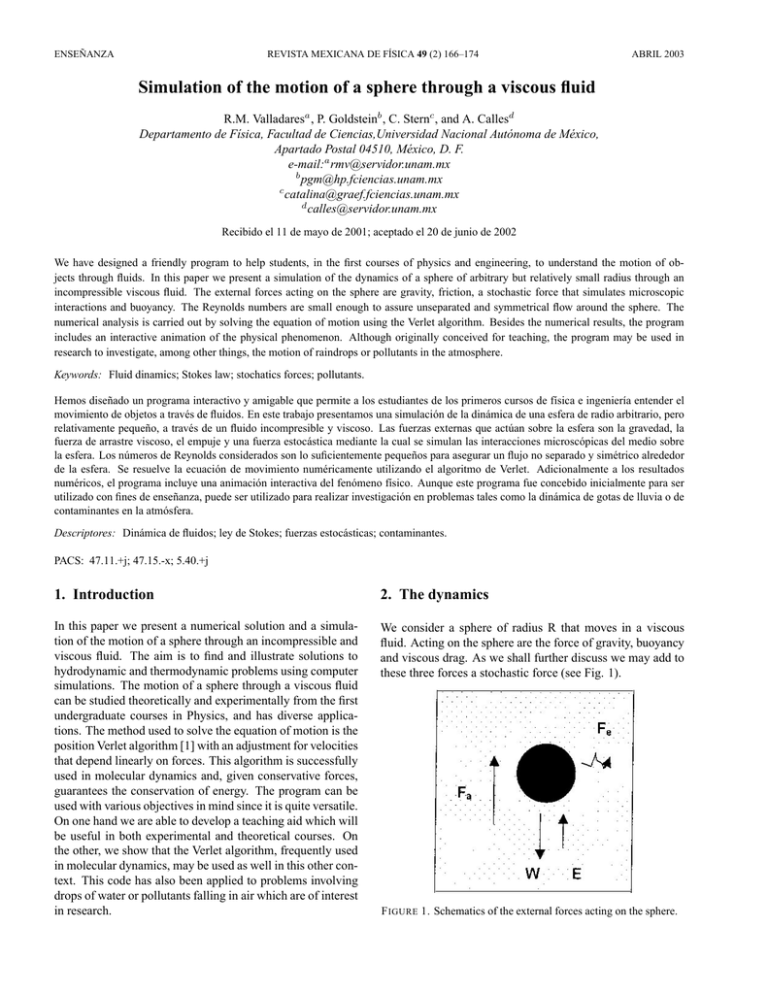
ENSEÑANZA REVISTA MEXICANA DE FÍSICA 49 (2) 166–174 ABRIL 2003 Simulation of the motion of a sphere through a viscous fluid R.M. Valladaresa , P. Goldsteinb , C. Sternc , and A. Callesd Departamento de Fı́sica, Facultad de Ciencias,Universidad Nacional Autónoma de México, Apartado Postal 04510, México, D. F. e-mail:a [email protected] b [email protected] c [email protected] d [email protected] Recibido el 11 de mayo de 2001; aceptado el 20 de junio de 2002 We have designed a friendly program to help students, in the first courses of physics and engineering, to understand the motion of objects through fluids. In this paper we present a simulation of the dynamics of a sphere of arbitrary but relatively small radius through an incompressible viscous fluid. The external forces acting on the sphere are gravity, friction, a stochastic force that simulates microscopic interactions and buoyancy. The Reynolds numbers are small enough to assure unseparated and symmetrical flow around the sphere. The numerical analysis is carried out by solving the equation of motion using the Verlet algorithm. Besides the numerical results, the program includes an interactive animation of the physical phenomenon. Although originally conceived for teaching, the program may be used in research to investigate, among other things, the motion of raindrops or pollutants in the atmosphere. Keywords: Fluid dinamics; Stokes law; stochatics forces; pollutants. Hemos diseñado un programa interactivo y amigable que permite a los estudiantes de los primeros cursos de fı́sica e ingenierı́a entender el movimiento de objetos a través de fluidos. En este trabajo presentamos una simulación de la dinámica de una esfera de radio arbitrario, pero relativamente pequeño, a través de un fluido incompresible y viscoso. Las fuerzas externas que actúan sobre la esfera son la gravedad, la fuerza de arrastre viscoso, el empuje y una fuerza estocástica mediante la cual se simulan las interacciones microscópicas del medio sobre la esfera. Los números de Reynolds considerados son lo suficientemente pequeños para asegurar un flujo no separado y simétrico alrededor de la esfera. Se resuelve la ecuación de movimiento numéricamente utilizando el algoritmo de Verlet. Adicionalmente a los resultados numéricos, el programa incluye una animación interactiva del fenómeno fı́sico. Aunque este programa fue concebido inicialmente para ser utilizado con fines de enseñanza, puede ser utilizado para realizar investigación en problemas tales como la dinámica de gotas de lluvia o de contaminantes en la atmósfera. Descriptores: Dinámica de fluidos; ley de Stokes; fuerzas estocásticas; contaminantes. PACS: 47.11.+j; 47.15.-x; 5.40.+j 1. Introduction 2. The dynamics In this paper we present a numerical solution and a simulation of the motion of a sphere through an incompressible and viscous fluid. The aim is to find and illustrate solutions to hydrodynamic and thermodynamic problems using computer simulations. The motion of a sphere through a viscous fluid can be studied theoretically and experimentally from the first undergraduate courses in Physics, and has diverse applications. The method used to solve the equation of motion is the position Verlet algorithm [1] with an adjustment for velocities that depend linearly on forces. This algorithm is successfully used in molecular dynamics and, given conservative forces, guarantees the conservation of energy. The program can be used with various objectives in mind since it is quite versatile. On one hand we are able to develop a teaching aid which will be useful in both experimental and theoretical courses. On the other, we show that the Verlet algorithm, frequently used in molecular dynamics, may be used as well in this other context. This code has also been applied to problems involving drops of water or pollutants falling in air which are of interest in research. We consider a sphere of radius R that moves in a viscous fluid. Acting on the sphere are the force of gravity, buoyancy and viscous drag. As we shall further discuss we may add to these three forces a stochastic force (see Fig. 1). F IGURE 1. Schematics of the external forces acting on the sphere. 167 SIMULATION OF THE MOTION OF A SPHERE THROUGH A VISCOUS FLUID Buoyancy, given by Archimedes principle asserts that a body in a fluid experiences an apparent reduction in weight equal to the weight of the displaced fluid. The drag force associates all forces that resist the motion of the sphere due to friction (viscosity) or to the motion of the fluid close to the sphere. In general, the drag force cannot be represented in a simple mathematical way since, besides the effect due to viscosity (viscous drag), for Reynolds numbers larger than five, the form of the wake (form drag) is determinant in describing the behavior of the sphere. We recall that the Reynolds number is an adimensional parameter that characterizes the flow and is given by Re = 2Rvρ , η (1) where v is the uniform speed of the flow, η is the viscosity and ρ the density of the fluid. For small Reynolds numbers, the flow around the sphere is symmetrical and does not separate, and the drag can be considered to be due only to friction forces over the surface of the sphere. Stokes [2] calculated the drag force for a static sphere in a steady, uniform, infinite viscous and incompressible flow (or a sphere that moves through a static fluid) for sufficiently small Reynolds numbers, Fa = −cv = −(6πηR)v. (2) Parameter c is of geometric origin, and has been calculated for geometries other than spheres. Comparison of Eq. (2) with experiments show that for Re< 0.5 the expression is very good and accurate to about 10% for Re close to 1 [3]. For Reynolds numbers larger than five the wake behind the sphere gets more and more complicated as the speed increases. This form drag can be reduced designing aerodynamic objects that diminish the wake. The value of various geometrical factors as well as the evolution of the wake with Reynolds numbers can be found in any introductory book of fluid mechanics [2, 4]. For solid particles falling in air, the geometry correction is negligible. In this paper we limit our analysis to small Reynolds numbers in which the drag is due only to viscosity, and a simple mathematical form can be assumed. If we consider a particle subject to gravity, buoyancy and drag as mentioned above, the balance of the three forces will determine whether the motion will be uniform or accelerated. In the examples shown below, the initial motion is accelerated and, under certain conditions, as the drag force increases with speed the forces balance out and the particle attains terminal (constant) speed. Equation (2) was obtained for steady conditions so in the acceleration phase additional terms must be considered. One of those terms is related to the resistance of the nonviscous fluid to the motion of the particle. It can be obtained by adding a certain mass of the fluid to the true mass of the sphere and is called virtual or added mass. Added mass effects are usually associated with bodies immersed in liquids because their density is larger than in gases [3]. In the case of small solid particles or raindrops falling in air the added mass effect is of the order of 10−3 or smaller. The other term, proposed originally by Basset, is related to the diffusion of vorticity. It is also more important in liquids than in gases and for regimes with high Reynolds numbers. The term can be neglected in the examples that we show below. When the motion of fluid spheres in another fluid is considered the recirculation of the fluid at the interface might play an important role. This is true however only for gas bubbles in a liquid. In the case of raindrops it has been shown that they behave like solid particles: when they are very small Eq. (2) is valid and for higher Reynolds numbers the drag depends on the complex flow that surrounds the sphere. In addition to the three forces mentioned above we may propose the existence of a stochastic force that depends on the temperature and which allows the study of cases in which Brownian motion might be of interest. The form of this stochastic force [5] is · Fe = GRAN 2ckB T ∆t ¸ 21 , (3) where GRAN is a random number with a Gaussian distribution centered at zero and standard deviation 1, kB is Boltzmann’s constant, T is the absolute temperature, c is the coefficient in Stokes’ formula [Eq. (2)]. In molecular dynamics it is common to use stochastic motion equations to carry out the sampling of a canonical ensemble. The dynamic equation for the sphere in one dimension is therefore given by the following Langevin type equation [4]: m dv d2 x = m 2 = −cv + FT , dt dt (4) where the total force FT is given by FT = mg − V ρg + Fe , (5) and c = 6πηR, V the volume displaced by the sphere and m is the sphere’s mass. 3. The Verlet algorithm In order to solve Eq. (4) numerically we turn to the Verlet algorithm so frequently used in molecular dynamics [1]. We now make a brief description of the Verlet algorithm with a modification to account for forces that have a linear dependence on velocity such as Stokes’ drag force. Let us call the time step of the Verlet algorithm h=∆t where h is assumed very small compared to the normal time scale of the problem. To calculate the position and velocity we use a Taylor series expansion for x(t + h): µ ¶ µ ¶ dx 1 d2 x x(t + h) = x(t) + h+ h2 + . . . , (6) dt t 2 dt2 t Rev. Mex. Fı́s. 49 (2) (2003) 166–174 168 R.M. VALLADARES, P. GOLDSTEIN, C. STERN, AND A. CALLES and µ x(t − h) = x(t) − dx dt ¶ h+ t 1 2 µ 2 d x dt2 to calculate x(h) we need x(-h) which we obtain from Eq. (7) to second order: ¶ h2 − . . . (7) t Adding Eqs. (6) and (7) up to second order we find x(t + h) = 2x(t) − x(t − h) + a(t)h2 . (8) On the other hand subtracting Eq. (7) from Eq. (6) we find µ ¶ dx x(t − h) − x(t + h) = 2h , (9) dt t (10) Since the force depends on the velocity, the position at time t + h will depend on the velocity at time t, and this velocity requires the expression for x(t + h). If we write where 1 b=g− m F (t) = b − c0 v(t), m ( · RAN V ρg + G ¸ 21 ) 2ckB T ∆t , and c m and substitute it into Eq.(8) we have c0 = x(t + h) = 2x(t) − x(t − h) + [b − c0 v(t)] h2 . (11) Substituting eq.(10) and factorizing, µ ¶ µ ¶ c0 h c0 h x(t+h) 1+ =2x(t)−x(t−h) 1+ +bh2 , (12) 2 2 we have finally that the uncoupled equations to solve by iterations are à ! c0 h 2x(t) − x(t − h) 1 + + bh2 2 à ! x(t + h) = (13) 1 + c0 h 2 and x(t + h) − x(t − h) , (14) 2h which constitute the modified Verlet algorithm for forces that have a linear dependence on velocity. For t = 0 we have v(t) = x(0) = 0, v(0) = v0 , a(0) = a0 = g − 1 m ρV g + c0 v0 − Gran à With these values for the initial position and velocity, iterating we can generate all the previous values for both position and velocity at time intervals of h. This algorithm, aside from being fast and reliable, is quite compact and easy to program [1]. 4. Applications so the expression for the velocity turns out to be: µ ¶ dx x(t + h) − x(t − h) v(t) = = . dt t 2h a(t) = 1 1 x(−h)=x(0)−v(0)h+ a(0)h2 =x0 −v0 h+ a0 h2 . (15) 2 2 2ckB T ∆t ! 21 , In this paper two different applications of the software, that we think are of interest to students and researchers, are considered. The results are presented in the next section. The first phenomenon studied is the precipitation of raindrops of different radii (from 1x10−5 to 1x10−3 m.). Each radius is kept constant throughout the fall. However, an option for a variable radius exists in the program, and more sophisticated models can be easily introduced. The motion of each drop depends on the size. The smallest drops remain floating in the air, the middle one acquires very soon terminal speed, and most of the trajectory has constant velocity. The bigger drops remain in accelerated motion. The second application refers to the motion of pollutants in the atmosphere. Five different materials in two typical sizes are considered. From this very simple model it can be seen that the smallest pollutants can remain floating in the air that we breathe for long periods of time. The stochastic force always has a small but noticeable effect in the motion of the pollutants. 5. Results Using the previous equations and initial conditions, an interactive program in C language was written to calculate position and velocity as a function of time. The program was developed for PC in MS-DOS environment, and shows an animation of the motion. The parameters and initial conditions can be changed easily using special keys. An example of a screen that will appear to the student is shown in Fig. 2 (see the appendix for details). The program can do up to five numerical experiments simultaneously. Spheres are dropped inside “tubes” filled with a particular fluid at a given temperature. The use of the tubes is only for visual effects. All hypotheses consider the motion of a sphere in an infinite medium. The program has a database of ten different fluids and twenty-four possible materials for the spheres. Table I has the values of the densities and viscosities of the fluids in SI units. Table II has the densities of the materials for the spheres. Figure 2 shows the simulation of the fall of water drops with radii varying from 1x10−5 to 1x10−3 m. The time step used in the integration is 0.004s. The starting point is in the middle of the screen. The smallest drops do not seem to Rev. Mex. Fı́s. 49 (2) (2003) 166–174 SIMULATION OF THE MOTION OF A SPHERE THROUGH A VISCOUS FLUID 169 F IGURE 2. Simulation of the fall of water drops with radii varying from 1x10-5 to 1x10-3 m. TABLE I. Fluid Vacuum Air Water Oil (10) Oil (20) Oil (30) Oil (40) Oil (50) Glycerine Helium Density (kg/m)3 0 1.293 1000.0 910 910 910 910 910 1270 0.18 Viscosity (kg/ms) 0 0.000018 0.001 0.079 0.170 0.310 0.430 0.630 0.1 0.00001 move. They float without falling in the time scale considered. The reason is that there is a minimum size for water drops to precipitate. The two drops on the right are much bigger and touch the bottom very soon: 0.464s and 0.456s as shown on top of their respective tubes. Their Reynolds number was already high after 0.4s, and the assumption of symmetrical flow around them was probably not valid in the last part of their trajectory. Figures 3 and 4 show the position and speed of the drops as a function of time. Particle 1 moves very little with speed close to zero, particles 2 and 3 attain terminal velocity very soon, and particles 4 and 5 remain in accelerated motion. The simulation is a close approximation only for the first two raindrops whose motion remains at very small Reynolds numbers. For drop number three the type of motion is correctly described even though the actual values of the speed and position are not accurate. The Reynolds numbers of the last two raindrops are too big to be described by this theory. The stochastic force due to temperature is extremely small in these experiments, its effect can be neglected. F IGURE 3. Position of the water drops as a function of time. For the two smallest particles the graphs are straight lines almost from the beginning because they soon attain terminal velocity, and move at constant speed. The third particle starts with accelerated motion (curved line) but eventually attains terminal velocity. The two bigger particles fall with accelerated motion all the time. Rev. Mex. Fı́s. 49 (2) (2003) 166–174 170 R.M. VALLADARES, P. GOLDSTEIN, C. STERN, AND A. CALLES TABLE II. Material Steel Asphalt Sulphur Clay (1) Clay (2) Sand (dry) Asbestos Coal (M) Coal (V) Wax Concrete Cork Glass fiber Chalk Graphite Ice Soot Brick Wood Paper Petroleum Lead Helium Water Density (kg/m)3 7850 1200 1960 1800 2600 1600 2500 1200 300 960 2400 200 100 1800 100 960 1600 1400 500 700 800 11400 0.18 1000 F IGURE 4. Velocity of the water drops as a function of time. The speed of the first drop remains almost zero. The speed of the second is constant most of the time. The third shows a clear change of behavior. Drops 4 and 5 move with constant acceleration Figure 5 shows the fall in air from a height of one meter of five different contaminants: lead, soot, sulfur, clay and coal. All spheres have a radius of 5x10−6 m. These are typical sizes for PM-10 pollutants in the air. The particles fall very slowly so the integration time has been increased (0.04s). The program can be stopped either when the first or when the last particle touches the ground. In this experiment the lead particle touched the bottom at 28.92s as can be seen at the top F IGURE 5. Simulation of the fall in air from a height of one meter of five different PM-10 (radius of 5x10-6 m) contaminants: lead, soot, sulfur, clay and coal. Rev. Mex. Fı́s. 49 (2) (2003) 166–174 SIMULATION OF THE MOTION OF A SPHERE THROUGH A VISCOUS FLUID of the corresponding tube. The other four particles are still in the air. The instant at which they touch the ground will appear above the positions and velocities at the top of each tube. Their Reynolds number appears at the bottom. In the case of variable radius, the size would be shown in this space also. As can be seen, all Reynolds numbers correspond to the range where our hypothesis is valid. The parameters of the experiment appear below each tube. The total time up to the instant when (S) was typed (31.640s) appears at the top right corner of the screen. Figure 6 shows the graph of speed as a function of time for each of the particles. All particles start downwards with accelerated motion. Eventually, the drag force increases with speed, and soon the sum of the Stokes and the buoyancy forces balances the weight. The particles seem to attain terminal speed and continue at constant speed. However, if the proper scale is plotted like in Fig. 7, it can be seen that there is always a small variation around the terminal speed. This is due to the stochastic force. In Fig. 8 position is plotted as a function of time. The stochastic effect is not observed at this scale. The graph shows straight lines as if all particles moved at constant speed. When the particle touches the bottom, the position remains constant. To study the effect of the stochastic force in more detail, the simulation might be carried out without gravity as shown in Fig. 9. The particles oscillate about the origin, this figure shows an instant of time. Figures 10 and 11 show the speed and position of the particles as a function of time. The particles have a random motion about the origin with an amplitude that seems to depend on the mass. These results are valid in a direction perpendicular to the fall. For this simulation the distance interval between top and bottom was reduced 171 F IGURE 7. Small variations about the terminal speed due to the stochastic force. F IGURE 8. Position is plotted as a function of time for PM10 particles. The stochastic effect is not observed at this scale. The graph shows straight lines as if all particles moved at constant speed. When the particle touches the bottom, the position remains constant. F IGURE 6. Velocity as a function of time for each of the PM10 particles. All particles start downwards with accelerated motion. All particles seem to attain terminal velocity, and continue at constant speed. However, if the proper scale is plotted like in Fig. 7, it can be seen that there is always a small variation around the terminal speed. This is due to the stochastic force [-5 x10−5 , -5 x10−5 m] but the same time increment (0.04s) was used in the integration. To study random signals it is often convenient to use statistical methods. Figure 12 shows a histogram of the position of coal without gravity for a very long run. The histogram shows the number of times a certain value is attained during the run. It can be observed that the highest values corresponds to the origin. The particle goes up or down randomly. It could be expected that as we let the time go to infinity, the peak at the origin will increase and the histogram will be more symmetric showing that the number of times the particles goes above the origin is the same as the number of times it goes below. Rev. Mex. Fı́s. 49 (2) (2003) 166–174 172 R.M. VALLADARES, P. GOLDSTEIN, C. STERN, AND A. CALLES F IGURE 9. Simulation of the motion of PM10 particles without gravity. lead particles will remain in the air for over 12 minutes, but the ones made out of the four other materials will take over an hour to touch the ground. In the case of the smaller PM2.5 pollutants, the lead ones will remain in the air over 3 hours but the other materials will remain floating between 20 to 30 hours if emitted by a tall chimney. If we consider only the first 3m above the ground, where we breathe, the less dense particles will remain in the air over 2 hours. Thus, these smaller particles may be considered hazardous to health and represent one of the main causes of air pollution. F IGURE 10. Position of PM-10 particles without g as a function of time. The particles have an erratic motion whose amplitude seems to depend on the mass. The speeds and positions for the fall of smaller contaminants, PM-2.5 (with a radius of 1.25 x 10−6 m.) are shown in Figs. 13 and 14. These particles being smaller fall more slowly, and the effect of the stochastic force can be detected in the velocity. All positions start as a curve as in accelerated motion but eventually become straight lines. If we consider that pollutants are ejected into the atmosphere by chimneys about 25m high, using the data obtained in the simulation we can conclude the following. The 5µ F IGURE 11. Velocity of PM-10 particles without g as a function of time. Rev. Mex. Fı́s. 49 (2) (2003) 166–174 SIMULATION OF THE MOTION OF A SPHERE THROUGH A VISCOUS FLUID F IGURE 12 A . Position of PM-2.5 (radius of 1.25 x10-6 m) particles as a function of time. The particles have an erratic motion whose amplitude seems to depend on the mass. 173 F IGURE 14. Velocity of PM-2.5 particles as a function of time. The particles have an erratic motion superposed to the fall. Note that the speed diminishes before it becomes approximately constant. It is interesting to note that even this simple model gives information on phenomena studied by meteorologists. 6. Animation as a teaching tool The teacher can use the software presented in this paper in various ways. F IGURE 12 B . Histogram corresponding to Fig. 12a. The highest frequency corresponds to the origin. 1. In early undergraduate Physics courses, students may easily compare experimental measurements of different falling spheres in different fluids with the numerical predictions. At this level we recommend eliminating the stochastic term. This program is friendly enough to allow students to change the parameters according to the real experiments that may be achieved in the lab. This experience will enable students to understand the utility of “numerical” experiments as useful tools to plan actual experiments, determine the best parameters to be used in the laboratory, and predict results. 2. In an advanced course, the stochastic term may be included and the student may visualize the numerical results of a stochastic phenomenon described by the Langevin equation. In order to enhance the stochastic behavior, the gravity term might be omitted. Statistical methods can be used to determine the mean speed and the rms values. 3. In a numerical analysis course, this program may be useful as an example of the application of the Verlet algorithm as well as the use of C code in visualization. F IGURE 13. Position of PM-2.5 (radius of 1.25 x10-6 m) particles as a function of time. 4. This program can be used in different research problems. It actually may be useful in dealing with problems such as the precipitation of raindrops and the dispersion of pollutants. We have specifically presented in this work the cases of the PM-10 and PM-2.5 particles that represent the main cause of pollution by particles in Mexico City. Rev. Mex. Fı́s. 49 (2) (2003) 166–174 174 R.M. VALLADARES, P. GOLDSTEIN, C. STERN, AND A. CALLES Appendix How to use the program This program is easier to use in an MS-DOS environment even though it can also be accessed from Windows. The main executable file is called “Spheres”. This program uses a file called ”fall.dat” where the information for the experiment is kept. The structure of ”fall.dat” is described below. Information for different experiments should be kept in files called ”fall*.dat” where * denotes a number. Once “Spheres” is executed the names and work places of the authors will appear. The letter (C) is used to continue. The program first lets the user choose among four languages. Once the language is chosen an (C) is typed, it asks if it should run with the data kept in file ”fall.dat”. If this is the case, the letter (C) should be typed. If not, the letter (o) is typed and the program asks for the number in ”fall*.dat”. Once the data file is chosen and (C) is used to continue, a ”friendly screen” like the one in figure (5) appears. The screen can be easily modified following the instructions on the top. With the letter N (n) the number of tubes can be increased (decreased) from 1 to 5. With the letter (G) the program keeps the data of the new run in “data*.res”. To change the characteristics of one of the tubes, the user has to type the number of the tube. Then the characteristics are highlighted in another color. With (E) one can modify the material of the sphere (density), with R the radius, with (F) the fluid (density and viscosity), with (T) the temperature, with (G) the acceleration of gravity and with (D) the positions of the top and bottom of the tube. With (Q) one enters the non-highlighted screen. All data is given in SI units. Once the parameters of each experiment have been chosen, the program runs while showing the simulation. The program ends when the slowest particle touches the bottom or the top of the tube but it can be stopped by the user at any instant with [S] and continued with [C]. With (E) it can be reinitiated. With [Esc] the user can exit the program at any time. The total time appears on the top right corner of the screen. The time at which the sphere touches the bottom and its instantaneous position and velocity appear at the top of each tube. The positions of the top and bottom of the tube are marked. The Reynolds number, the size of the radius of the sphere if it is not constant andthe characteristics of the sphere and of 1. M.P. Allen and D.J. Tildesley, Computer Simulations of Liquids (Clarendon Press, Oxford, 1997). 2. R.W. Fox and A.T. Mc Donald, Introduction to Fluid Dynamics (John Wiley and Sons, 4th edition, 1998). 3. R.L. Panton, Incompressible Flow (John Wiley and Sons, 1984). the fluid appear at the bottom of each tube. For the sphere the characteristics are the material with its density and radius and for the fluid the density, viscosity and temperature. The value of the acceleration due to gravity can also be changed. Some data files with various characteristics have been created but the user can create new files depending on the nature of the study. For example, the data file used to study the motion of water drops of different sizes as they fall in air is kept as fall1.dat, see Table AI. TABLE AI. 5 -1 0.004 24 2 0.0 0.0 1.0E-5 15.0 -1 1 9.8 0 24 2 0.0 0.0 5.0E-5 15.0 -1 1 9.8 0 24 2 0.0 0.0 1.0E-4 15.0 -1 1 9.8 0 24 2 0.0 0.0 5.0E-4 15.0 -1 1 9.8 0 24 2 0.0 0.0 1.0E-3 15.0 -1 1 9.8 0 In the first line, the first number indicates the number of possible ”tubes”. The second number indicates whether it should stop when the first particle touches the ground (-1), when the last one touches the ground (1) or continue indefinitely (0). The third number indicates the time increment in the integration. The following lines have the same format. The first number corresponds to the solid as found in “solids.dat” (see Table I). The second number corresponds to the fluid as it appears in “fluids.dat” (see Table II). The following numbers correspond respectively to the initial position and velocity, the radius, the positions of the top and bottom of the tubes measured from the starting points, the acceleration of gravity and the option of having constant (0) or variable (1) radius. The only subroutine for variable radius implemented in the program considers linear growth. However other models can be implemented in the software. If the letter [G] is chosen on the screen, the data of velocity and position as a function of time is saved in file “res*.dat”. They can be retrieved easily and plotted. The executable file can be obtained with any of the authors. A detailed manual in Spanish is in process. 4. M.C. Potter and J.F. Foss, Fluid Dynamics (John Wiley and Sons, 1975). 5. F. Reif, Fundamentals of Statistical and Thermal Physics (Mc Graw-Hill International Editions, 1965). Rev. Mex. Fı́s. 49 (2) (2003) 166–174
